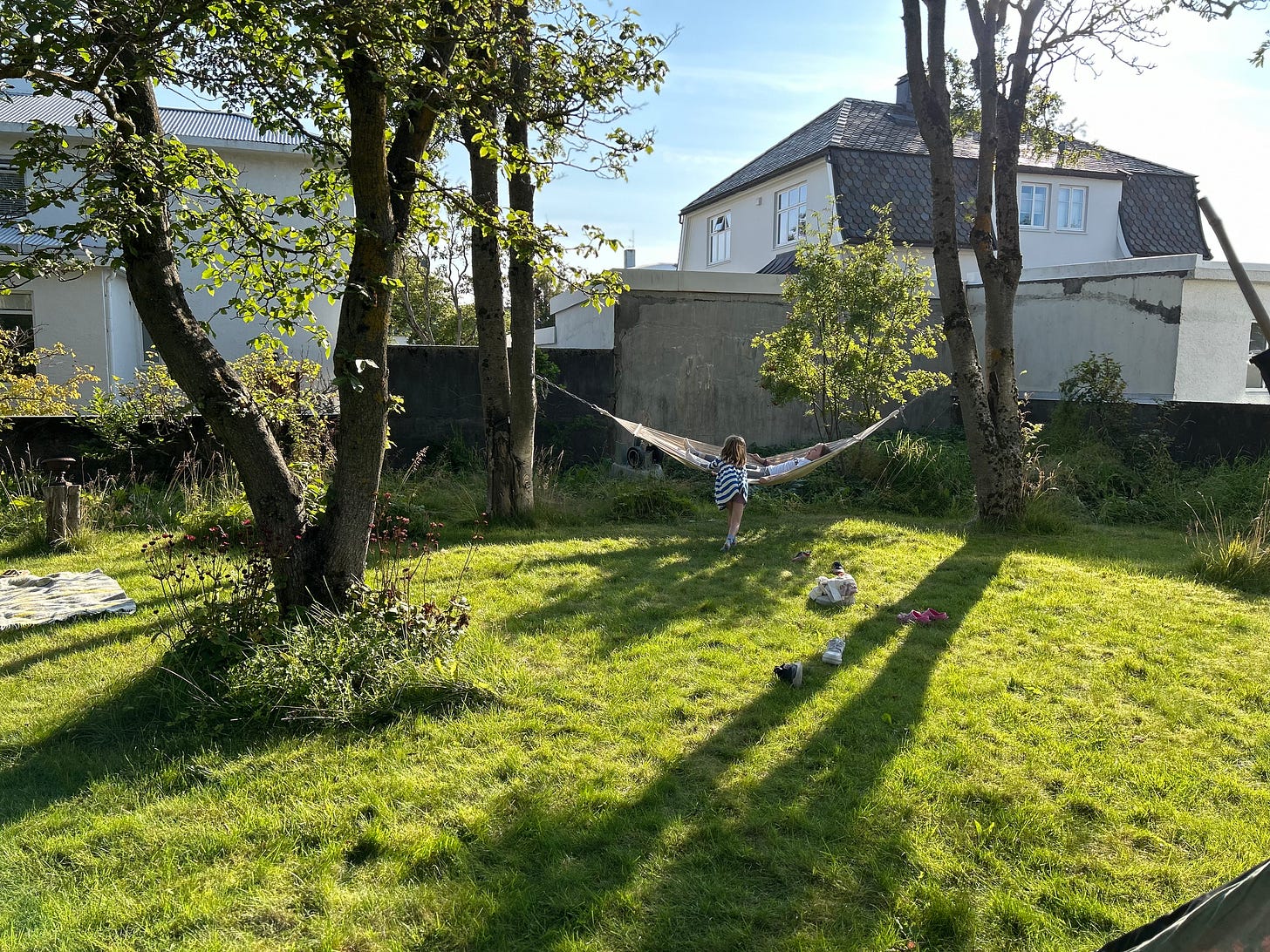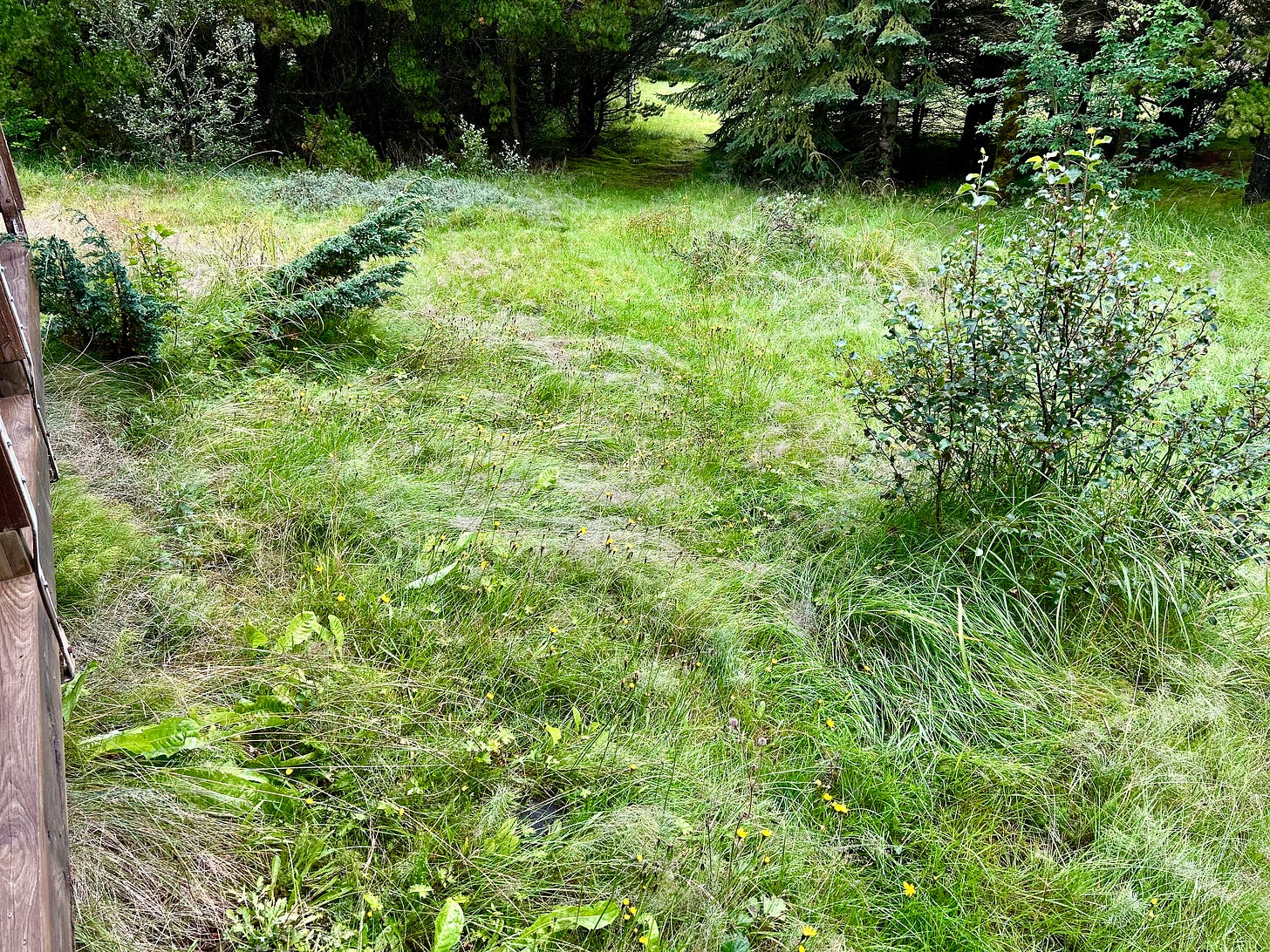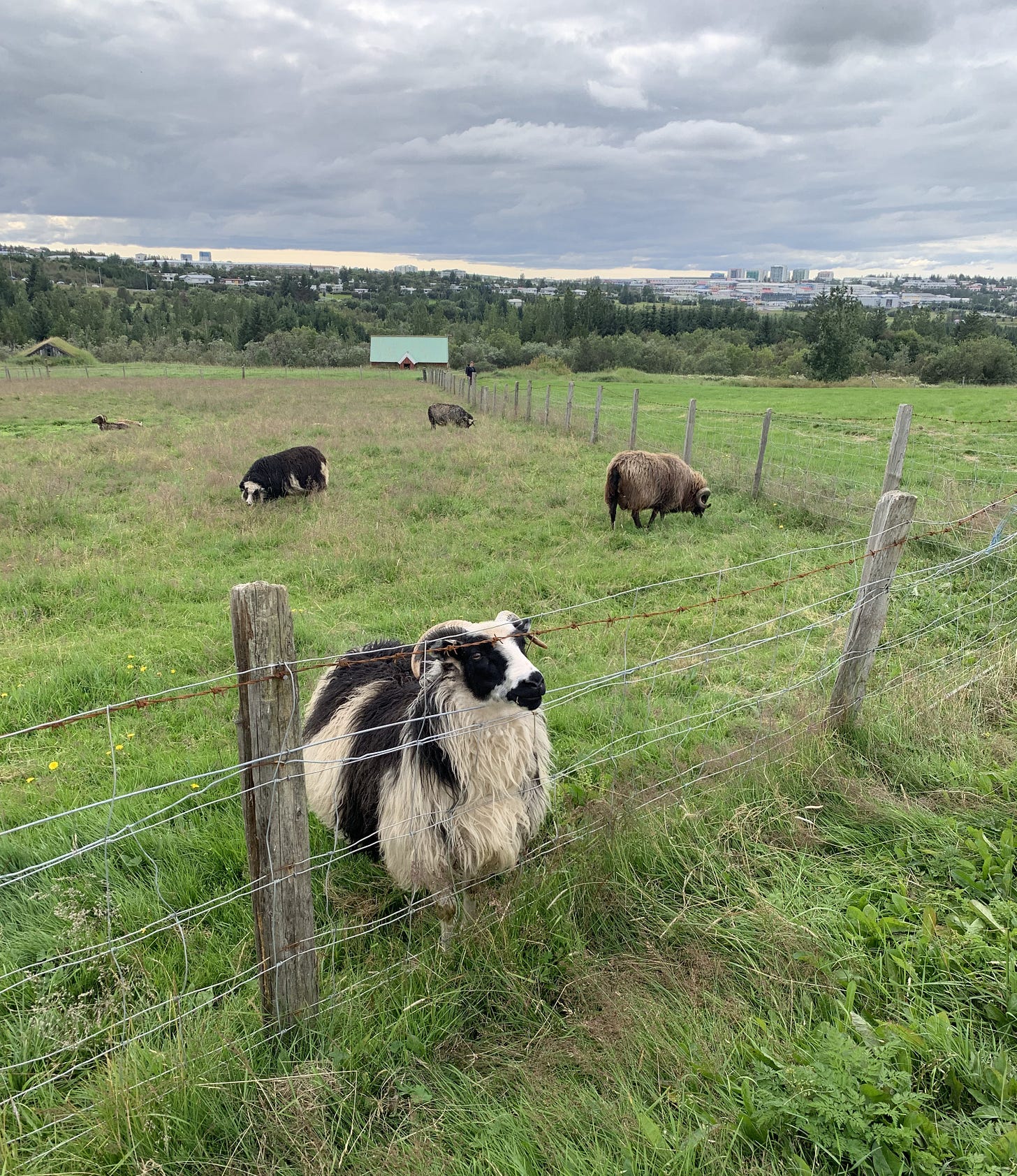On shifting interests and writing a newsletter
Considering my August travels over an ocean and through books and what it means for this newsletter
The lovely Alys Hedd recently tossed me a Substack Note hot potato, asking me to answer: Why am I on Substack? Good question! To tackle it, I’ll start with a retro of this month…
Where I’ve been
This August, we went to Iceland for two weeks where my husband is from. It was our first flying trip with all three kids, not to mention our first family trip over an ocean and timezones, and it was… challenging. Next to my anxious nature and desire for control, my husband is a go-with-the-flow type. And even he struggled with all the absences: of daily routines, of our paid caregiver, of carefully placed baby gates that hem in the all-out torrent that are twin toddlers. (It will be a dark day when they realize you need to pull the handle up before you slide it sideways).
On my side of the equation, I knew this trip would be personally difficult. Routines and calm are my moat against disintegration. So, even though I took those weeks off work, I negotiated time on weekday mornings to myself, when my husband and mother-in-law would mind the kids.
Each morning, around 9:30, I waited for the Reykjavik Number 12 bus to take me downtown, where I’d plunk down at a coffee shop chosen precisely because it offered filterkaffi (no espresso for me, takk).
My plan for this solo time was to write.
Specifically, I was focused on external pieces. Having actual bylines will make my nonfiction book proposal more attractive to literary agents. Also, I’m finding essay writing so stimulating that I’d love to make it a real part of my life. “Real” in a subjective sense; for me, this means trying to publish beyond my own newsletter.1
Getting back to Alys’s question: Initially, I started newsletter-writing to channel the furious storm of research and writing that my autism diagnosis unleashed. It’s been about six months since that diagnosis, and I started this Substack not long after.
It was a productive decision, in a literal sense. Researching with a goal in mind creates a virtuous cycle where instead of idly wandering, you’re advancing with a critical eye.2 And then the satisfaction of having a testament to your work spurs you to create more.
Because I was so fascinated with autism at the start, that was my focal point. Though, knowing I dislike being constrained, I intentionally made my mission more capacious: I would write about the strangeness of the mind, a boundless topic, with a bias toward neurodivergence and neuroscience.
Best laid plans and all. At the beginning I barely sensed the constraint but now I keep bumping against it. During those filterkaffi mornings, none of my work was within the original bounds of this newsletter. Instead, my interests now sprawl across philosophy, literature, and criticism. Neurodivergent frames are still close at hand, but they’re not center stage.
Where I am
What’s happening, I realize, is the waning of one special interest and the rising of another. I had tricked myself into thinking it was all the same because it’s still writing, but now I’m flinging my own words back at myself: “writer: one word, too many referents, all tenuously grouped together.”
You see the shift in the reading I’m consuming these days. Here’s the story of my past month told through books purchased or borrowed:
Aesthetics, Method, and Epistemology by Michel Foucault
The Rhetoric of Fiction by Wayne C. Booth
Autotheory as Feminist Practice in Art, Writing, and Criticism by Lauren Fournier
Frantumaglia by Elena Ferrante
Feel Free by Zadie Smith
The artful edit: on the practice of editing yourself by Susan Bell
Between You and Me: Confessions of a Comma Queen by Mary Norris
The Western Canon by Harold Bloom
The White Man’s Guide to White Male Writers of the Western Canon by Dana Schwartz3
Previously, I connected my special interest cycling to this very newsletter, wondering if writing about autism would crash just as other interests have. But something was different, I noted then: my new awareness that this cycling
isn’t just idiosyncrasy; it’s part of a neurotype. Maybe I can learn to harness this special interest cycling with intention and avoid the prior pattern.
And avoiding that prior pattern might be what’s happening? I’m not yet at the burnout stage where the interest turns distasteful, like the sight of leftover birthday cake after you’ve had three slices. I’m just not freely turning toward my old go-to topics.
On Thursday, wondering what the hell I was going to publish this week, I perused my drafts inventory. I count 20 pieces in various states. Those are the graduates from my idea stable, where I dump post ideas so I don’t forget. That document has 84 ideas!
Many of them relate to autism or how minds work, the stuff of this newsletter. Going through them, I didn’t feel revulsion—but I didn’t immediately open a doc and start working either, which used to be the reflex.
Instead, I started writing this post.
My autism interest isn’t fully exhausted, but I think it would be soon if I forced myself to keep writing about it. Maybe I just need some time apart, some breathing room, to let my interest recharge. Because I do want to keep the spark alive for the kind of research and writing that first prompted Strange Clarity.
Where I’m going
What I’m circling is this question: do I let this newsletter follow my interests? Or, do I obey the chorus of platform-building advice, which is: have a clear niche, a delineated focus, so that readers interested in your topic can find you and once found, they get what they came for.
I do have a data point. The newsletter I published during my trip—on the god trick, mansplaining, other stuff—was more aligned with my current interests in literature and philosophy. A few readers commented and liked it, and it even prompted the first external response by the always fascinating Overweening Generalist. (His response is a work of art.) But the interest was muted compared with my posts on autism and neuroscience/pyschology.
Which is fine by me, so long as I’m not alienating readers who were drawn here on the promise of something else. Am I?
To return to Alys’s question, why am I on Substack? Why do I post this newsletter? The path out of my haze lies in the answer to that question.
But the answer is manifold; multiple reasons are competing with each other. I write this newsletter to connect with people who think like me (and people who don’t), to be an autism advocate in my own way, to develop my writing muscle, to provide a channel for my research and curiosity, to create an archive of my work (because I’ll forget otherwise), and to share my ideas with readers. In isolation, each of those goals would suggest a discrete path. Taken together, the compass needle lurches unsteadily from one point to another.
Feeling pulled in different directions is not new. I have been so many different people across my lifetime, often at the same time. Who I was depended on who I was with. Such that, if people from different milieus assembled, I wasn’t sure how to be. That sounds disordered, and I suppose it is, but I don’t view it entirely—or even mostly—negatively. Because it wasn’t people pleasing, not in the typical sense of doing something just for someone to like you. It’s more that I’ve never been able to pin myself down. I’m not one person. I can flit in and out of different personas and somehow, there’s a kernel of truth to all of them, even if the personas are exaggerated. The conventional advice when you’re diagnosed with autism is to unmask, but what if your real self is split across those masks?
Which makes the present quandary—attempting to write a newsletter as one person—both familiar and difficult to sort out.
Is this newsletter the place where I let my different intellectual selves coexist? Or is it the playground of just one?
That’s the lingering question.
So, Reader: Why do you read this newsletter? Your answer will help me think through this quandary. And if you write or create for others, how do you decide whether to follow your changing interests or hold fast to one focus?
With an unabashed goal of fishing up 100 rejections, I’ve been tracking my pitch activity. So far, I’ve cast 20 pitches, producing just two tugs on my line.
Back in June, a public philosophy journal asked for a draft of an essay I pitched on the distinction between art and craft. That was a while ago, but they assure me as of this week that they’re still awaiting review from a philosophy of art specialist. They take that step if they’re inclined to publish, though the two-month wait shows they’re not eager to publish. Anyway, the piece isn’t dead in the water yet.
In July, I pitched a literary criticism piece and earlier this month an editor asked to see a draft. I sent it two days ago, and he says I’ll hear back in a few weeks. Pitching is an exercise in patience.
Meaghan Green wrote recently on this topic in her newsletter Meadow Mind. She says that applying what you’ve read to create something new is “where the magic really happens […] where learning transforms into something tangible that you make all your own.” I agree. It’s a variation of Hegel’s dialectics: external ideas are synthesized with your internal ones and your mind transforms in the process.
If you’re interested, you can peruse these titles at my Bookshop.org page, where I added brief descriptions of each.








Relatable! I wrote “I’m not a brand. I’m a human.” a year or so into my Substack journey. For what it’s worth I’ve seen folks with narrow niches can struggle long term and others build wider audiences who are into the scope of whatever you do. Also I find that niching advice very high masking. I hope you find a way to make space to be your whole self here. 💙
Thanks for answering the question so fully, Laura. I enjoy your writing across all the topics I've read here - I find your style of writing particularly engaging, often hooking me into posts on subjects I might not have explored otherwise. I had trouble with the last one, but that was because I was in burnout and found reading anything difficult, so something challenging was never going to work! Keep following your mind to where it takes you - I feel like writing through a lens of neurodivergence means you can expand to whatever horizon you want, because the lens doesn't change, only the object we're focused on.